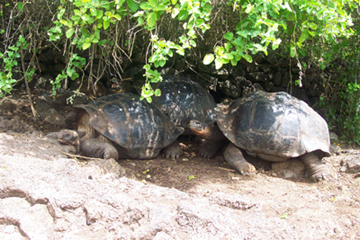When Spanish explorers first landed on a group of islands off the Pacific coast of South America, they were amazed to find the islands packed with giant tortoises — tens of thousands of them. The explorers called the islands the Galapagos — from the Spanish word for tortoise.
 Giant tortoises in the Galapagos. Credit: National Oceanic and Atmospheric Administration
Giant tortoises in the Galapagos. Credit: National Oceanic and Atmospheric AdministrationIt’s been a tough road for the tortoises ever since. But one group is making a comeback. In 2013, conservationists introduced more than 100 juveniles to tiny Pinzón Island.
When Europeans first arrived, they found that each major island had its own sub-species of giant tortoise. In fact, when Charles Darwin visited the islands in 1835, the differences in species helped him formulate his theory of evolution.
But whalers carted off tens of thousands of tortoises for meat and oil. And settlers brought goats, dogs, and especially rats, which gobbled up eggs and hatchlings. By the end of the 19th century, essentially no young tortoises were able to survive on Pinzón Island. So scientists began gathering adult tortoises from the island and breeding them in captivity.
In 2012, a specially designed poison was dropped on the island. It killed off the rats without harming other wildlife.
The following year, 118 juveniles were returned to the island. They joined a group of century-old tortoises that were born on Pinzón, and a group of younger adults that had been brought to the island earlier. That raised the Pinzón Island population to about 400 — giving the tortoises a chance to reclaim an island that was once their own.

